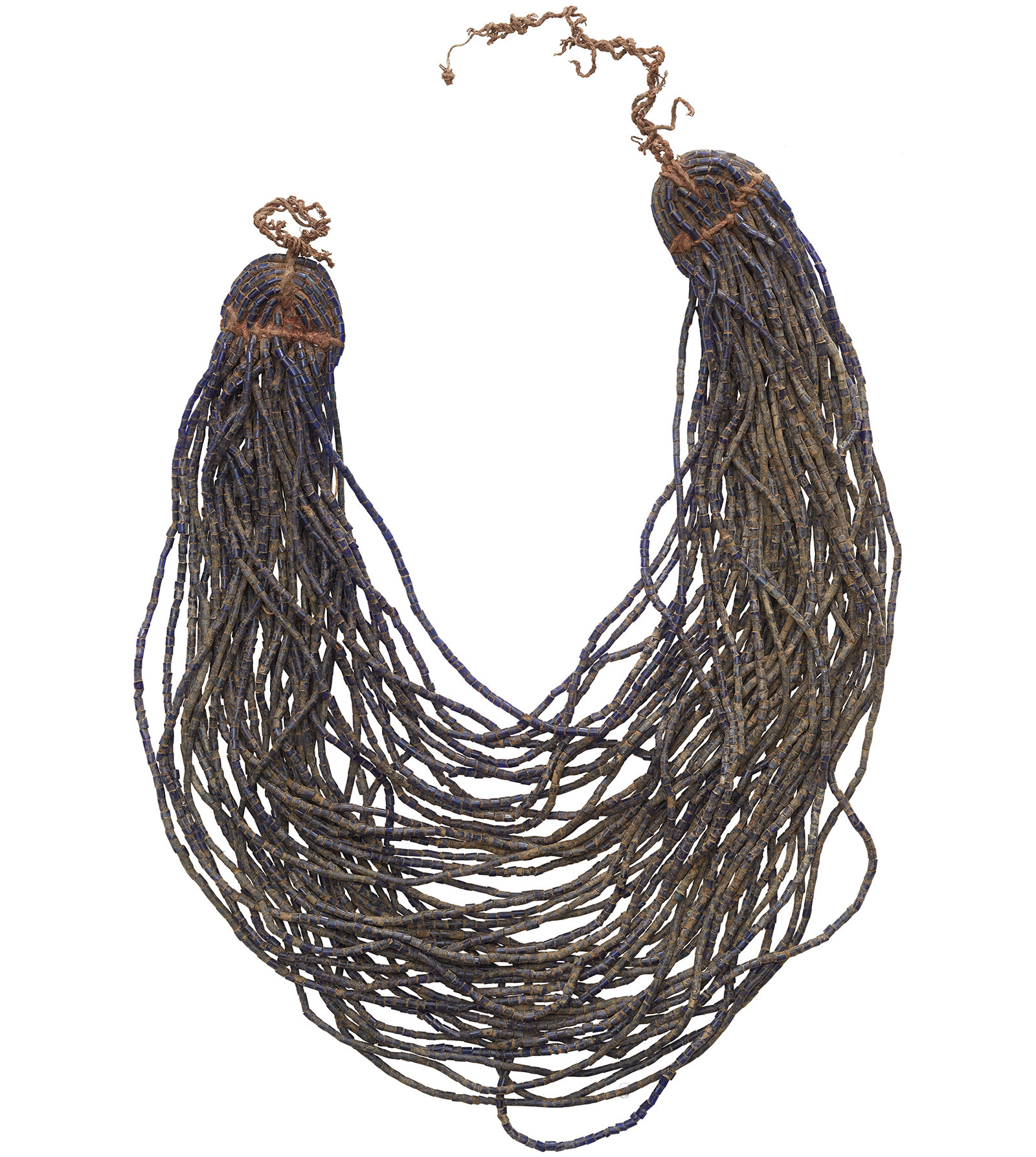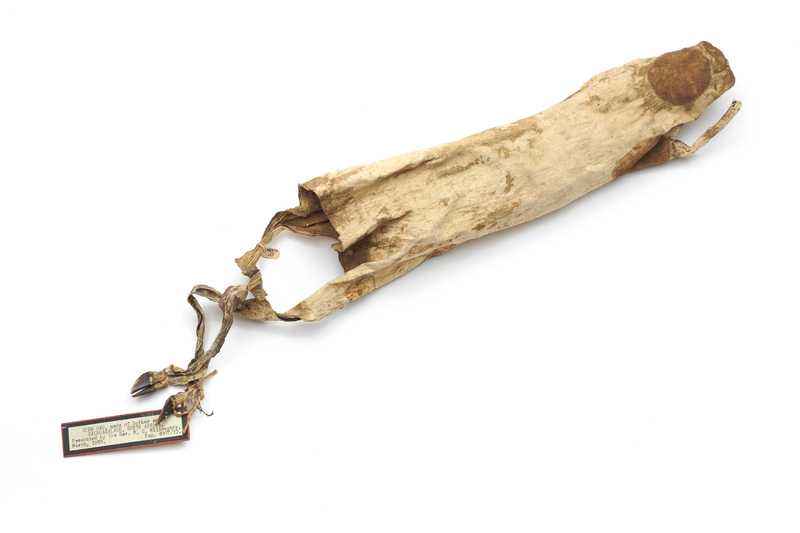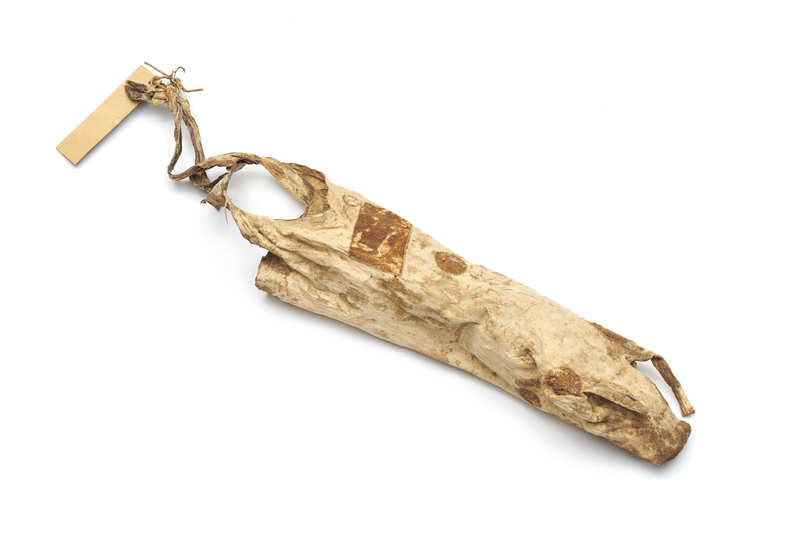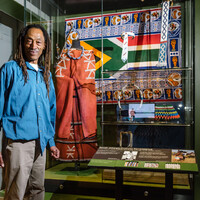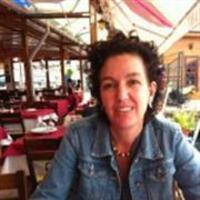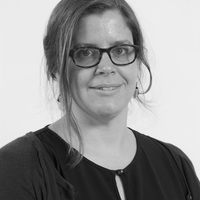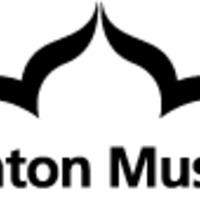Corn Bag; Sack; Quiver; Motsistana ; Motsisana; Motsitsana
Item
Title
Corn Bag; Sack; Quiver; Motsistana ; Motsisana; Motsitsana
Creator
Unrecorded
Description
Physical Description: Small sack made of the skin of a Duiker, a small antelope, with the legs and hind feet still attached and tied to form a strap. There are circular and square patches of a darker leather sewn on to form decoration or mends. Used for carrying a quiver and also might have been used to carry corn or provisions. [Royal Pavilion & Museums, 2019]
Contextual Description: It is an arrow quiver, but is also a useful bag for taking food, foraging along the way etc. TS comments
Contextual Description: 00:57:12 [SL and TN mime shooting arrows] This is a …There’s the real corn bag made out of a whole Kudu, and the way you remove, you don’t skin it like you normally do, you try to pull it out, so that you still have the whole [gestures shape]RHH: The shape
And this was like a corn sack. This is where you put your
RHH: this one is?
SL: No this one he says is for hunting
RHH: Ah so this is what you thought, the corn bags are a bigger animal?...This is for keeping your quiver in?
SL: Yeah, but what he was explaining was that you load [the corn] into a sledge and then you drag the load home and when you get here you transfer that into a grain storage basket. You remember in the last room we visited yesterday in the museum there was a basket, they used to make them bigger and that is where you would pour your corn. Transcription by KL of MAC_BB_20190817_RPM3 SL Interview with Tshupo Ntono, Village Elder, Language: Setswana with English translations by SL, 2019
And this was like a corn sack. This is where you put your
RHH: this one is?
SL: No this one he says is for hunting
RHH: Ah so this is what you thought, the corn bags are a bigger animal?...This is for keeping your quiver in?
SL: Yeah, but what he was explaining was that you load [the corn] into a sledge and then you drag the load home and when you get here you transfer that into a grain storage basket. You remember in the last room we visited yesterday in the museum there was a basket, they used to make them bigger and that is where you would pour your corn. Transcription by KL of MAC_BB_20190817_RPM3 SL Interview with Tshupo Ntono, Village Elder, Language: Setswana with English translations by SL, 2019
Contextual Description: WT 17:00
This was for carrying the things for the hunter
GK 17:05
this one
WT 17:08
when they are hunting they have this pouch for for bows, for arrows Now it says it's
SL 17:17
not one back
17:22
by the shoulder
SL 17:24
looks totally wrong. Never corn bag sack.
WT 17:28
No no its not its for slinging.
SL 17:38
I took it for an arrow quiver.
NS 17:42
Again it's quite large
GK 17:46
a bow bag because I mean I know this is something like
WT 17:51
the end that lays at the tip of the arrows They have small small ones. And then this one is bigger it has the big the arrows, then they take that smaller one and insert it inside. We have the in the collection in the museum. but also i dont know if there are Basarwa around here because if you go to [???] they will tell you but also if you see their pictures when they are running, they always have this... The basarwa
SL 18:32
corn sack.
WT 18:34
No defintely so
18:36
they didn't know any way the collectors
NS 18:38
it's about 73 centimetres long
SL 18:41
according to this 70 Normally you would have to have a complete arrow quiver. You need a root of an Acacia tree which you will make hollow by removing the centre part. And then you remain with that tube which would be what you fit in here, which I think helped to achieve this [shape] that's where you will contain your arrows
SL 19:24
I think it's from some small buck you can see the hooves
WT 19:30
what I've seen in the museum put it lightly like sugarcane because it's a little bit thick, but then it's hollow inside the explanation that you're giving...and then at the end the put leather they kind of solder some leather in there.
SL 19:48
in a SeTswana What is it called? Then maybe motsisana...the arrow quiver
The above notes are from a transcription by Kathleen Lawther of a discussion between Gase Kediseng, JoAnn McGregor, Nicola Stylianou, Scobie Lekhuthile and Winani Thebele which took place at the Khama III Memorial Museum on the 5th of August 2019. To listen to the full recording please follow the link below.
This was for carrying the things for the hunter
GK 17:05
this one
WT 17:08
when they are hunting they have this pouch for for bows, for arrows Now it says it's
SL 17:17
not one back
17:22
by the shoulder
SL 17:24
looks totally wrong. Never corn bag sack.
WT 17:28
No no its not its for slinging.
SL 17:38
I took it for an arrow quiver.
NS 17:42
Again it's quite large
GK 17:46
a bow bag because I mean I know this is something like
WT 17:51
the end that lays at the tip of the arrows They have small small ones. And then this one is bigger it has the big the arrows, then they take that smaller one and insert it inside. We have the in the collection in the museum. but also i dont know if there are Basarwa around here because if you go to [???] they will tell you but also if you see their pictures when they are running, they always have this... The basarwa
SL 18:32
corn sack.
WT 18:34
No defintely so
18:36
they didn't know any way the collectors
NS 18:38
it's about 73 centimetres long
SL 18:41
according to this 70 Normally you would have to have a complete arrow quiver. You need a root of an Acacia tree which you will make hollow by removing the centre part. And then you remain with that tube which would be what you fit in here, which I think helped to achieve this [shape] that's where you will contain your arrows
SL 19:24
I think it's from some small buck you can see the hooves
WT 19:30
what I've seen in the museum put it lightly like sugarcane because it's a little bit thick, but then it's hollow inside the explanation that you're giving...and then at the end the put leather they kind of solder some leather in there.
SL 19:48
in a SeTswana What is it called? Then maybe motsisana...the arrow quiver
The above notes are from a transcription by Kathleen Lawther of a discussion between Gase Kediseng, JoAnn McGregor, Nicola Stylianou, Scobie Lekhuthile and Winani Thebele which took place at the Khama III Memorial Museum on the 5th of August 2019. To listen to the full recording please follow the link below.
Publisher
Making African Connections
Date
Pre 1899
Type
PhysicalObject
Format
Whole: 730 mm x 130 mm x 80 mm
Animal skin; Duiker; Leather
Identifier
R4007/10
Source
Collected by Reverend William Charles Willoughby, a Christian missionary, in what was then the Bechuanaland Protectorate (1885-1966). It is now the Republic of Botswana, having gained independence from Britain in 1966.
From 1889-92 Willoughby was pastor at Union Street Church, Brighton (now The Font pub). From 1893 to 1898 he worked for the London Missionary Society in Bechuanaland. He assembled this collection of objects during this period. This was a period of social and technological changes and these objects represent traditional lifestyles and skills, rather than the contemporary lives of the people Willoughby met.
Willoughby's collection was loaned to Brighton Museum in 1899 when he returned to the UK. The loan was converted into a donation in 1936, and accessioned as acquisition R4007.
Some objects were re-numbered with the WA (World Art) numbering system in the 2000s. These numbers have been reverted to the original R4007/... numbers where possible for consistency in 2019.
From 1889-92 Willoughby was pastor at Union Street Church, Brighton (now The Font pub). From 1893 to 1898 he worked for the London Missionary Society in Bechuanaland. He assembled this collection of objects during this period. This was a period of social and technological changes and these objects represent traditional lifestyles and skills, rather than the contemporary lives of the people Willoughby met.
Willoughby's collection was loaned to Brighton Museum in 1899 when he returned to the UK. The loan was converted into a donation in 1936, and accessioned as acquisition R4007.
Some objects were re-numbered with the WA (World Art) numbering system in the 2000s. These numbers have been reverted to the original R4007/... numbers where possible for consistency in 2019.
William Charles Willoughby
Botswana, Southern Africa, Africa
1893-1898
Space/Place
Botswana, Southern Africa, Africa
Cultural Group: Tswana
Rights
Creative Commons Attribution-ShareAlike 4.0 International
Item sets
Linked resources
Filter by property
| Title | Alternate label | Class |
|---|---|---|
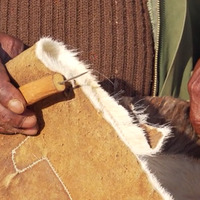 Leatherwork Leatherwork |

